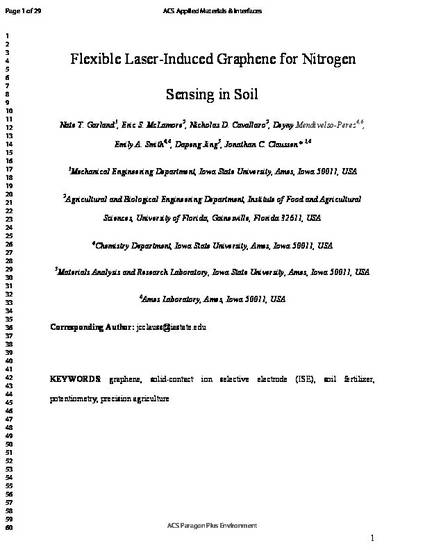
Flexible graphene electronics are rapidly gaining interest, but their widespread implementation has been impeded by challenges with ink preparation, ink printing, and post-print annealing processes. Laser-induced graphene (LIG) promises a facile alternative by creating flexible graphene electronics on polyimide substrates through a one-step laser writing fabrication method. Herein we demonstrate the use of LIG, created through a low-cost UV laser, for electrochemical ion selective sensing of plant-available nitrogen (i.e., both ammonium and nitrate ions: NH4+ and NO3-) in soil samples. The laser used to create the LIG was operated at distinct pulse rates (10, 20, 30, 40, and 50 ms) in order to maximize the LIG electrochemical reactivity. Results illustrated that a laser pulse rate of 20 ms led to a high percentage of sp2 carbon (77%) and optimal peak oxidation current of 120 uA during ferricyanide cyclic voltammetry. Therefore, LIG electrodes created with a 20 ms pulse rate were consequently functionalized with distinct ionophores specific to NH4+(nonactin) or NO3- (tridodecylmethylammonium nitrate) within polyvinyl chloride (PVC)-based membranes to create distinct solid contact ion selective electrodes (SC-ISEs) for NH4+ and NO3-ion sensing respectively. The LIG SC-ISEs displayed near Nernstian sensitivities of 51.7 ± 7.8 mV/decade (NH4+) and -54.8 ± 2.5 mV/decade (NO3-), detection limits of 28.2 ± 25.0 uM (NH4+) and 20.6 ± 14.8 uM (NO3-), low long-term drift of 0.93 mV/hr (NH4+) sensors and -5.3 μV/hr (NO3-) sensors and linear sensing ranges within 10-5-10-1 M for both sensors. Moreover, soil slurry sensing was performed and recovery percentages of 96% and 95% were obtained for added NH4+and NO3-, respectively. These results, combined with a facile fabrication that does not require metallic nanoparticle decoration, make these LIG electrochemical sensors appealing for a wide range of in field or point-of-service applications for soil health management.
Available at: http://works.bepress.com/jonathan_claussen/43/

This document is the unedited Author’s version of a Submitted Work that was subsequently accepted for publication in ACS Applied Materials and Interfaces, copyright © American Chemical Society after peer review. To access the final edited and published work see DOI: 10.1021/acsami.8b10991. Posted with permission.